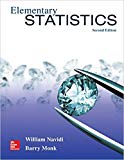
Concept explainers
Baby weights: According to a recent National Health Statistics Reports: the weight of male babies less than 2 months old in the United States is
- What proportion of babies weigh more than 13 pounds?
- What proportion of babies weigh less than 15 pounds?
- What proportion of babies weigh between 10 and 14 pounds?
- Is it unusual for a baby to weigh more than 17 pounds?
a.
To find: The proportion of baby weighs more than
Answer to Problem 28E
The proportion of baby weigh more than
Explanation of Solution
Given information:The mean is
Formula used:
Here, the mean is
Calculation:
Consider the formula for Z value.
Substitute
From the table of standard normal distribution, for the Z value less than
The proportion of baby weighs more than
Substitute the values in above equation.
Therefore, the proportion of baby weigh more than
b.
To find:The proportion of baby weighs less than
Answer to Problem 28E
The proportion of baby weighs less than
Explanation of Solution
Given information:The mean is
Formula used:
Here, the mean is
Calculation:
Consider the formula for Z value.
Substitute
From the table of standard normal distribution, for the Z value less than
Therefore, the proportion of baby weighs less than
c.
To find: The proportion of baby weighs between
Answer to Problem 28E
The proportion of baby weighs between
Explanation of Solution
Given information:The mean is
Formula used:
Here, the mean is
Calculation:
Consider the formula for Z value.
Substitute
From the table of standard normal distribution, for the Z value less than
Substitute
From the table of standard normal distribution, for the Z value greater than
The proportion of baby weighs between
Substitute the values in above equation.
Therefore, the proportion of baby weighs between
d.
To find:Whether it is unusual for a baby to weigh morethan
Answer to Problem 28E
It is unusual for a baby to weigh more than
Explanation of Solution
Given information:The mean is
Calculation:
The point value of mean is,
Since, the value do not lies in between the interval.
Therefore, it is unusual for a baby to weigh more than
Want to see more full solutions like this?
Chapter 7 Solutions
Elementary Statistics 2nd Edition
- Should you be confident in applying your regression equation to estimate the heart rate of a python at 35°C? Why or why not?arrow_forwardGiven your fitted regression line, what would be the residual for snake #5 (10 C)?arrow_forwardCalculate the 95% confidence interval around your estimate of r using Fisher’s z-transformation. In your final answer, make sure to back-transform to the original units.arrow_forward
- BUSINESS DISCUSSarrow_forwardA researcher wishes to estimate, with 90% confidence, the population proportion of adults who support labeling legislation for genetically modified organisms (GMOs). Her estimate must be accurate within 4% of the true proportion. (a) No preliminary estimate is available. Find the minimum sample size needed. (b) Find the minimum sample size needed, using a prior study that found that 65% of the respondents said they support labeling legislation for GMOs. (c) Compare the results from parts (a) and (b). ... (a) What is the minimum sample size needed assuming that no prior information is available? n = (Round up to the nearest whole number as needed.)arrow_forwardThe table available below shows the costs per mile (in cents) for a sample of automobiles. At a = 0.05, can you conclude that at least one mean cost per mile is different from the others? Click on the icon to view the data table. Let Hss, HMS, HLS, Hsuv and Hмy represent the mean costs per mile for small sedans, medium sedans, large sedans, SUV 4WDs, and minivans respectively. What are the hypotheses for this test? OA. Ho: Not all the means are equal. Ha Hss HMS HLS HSUV HMV B. Ho Hss HMS HLS HSUV = μMV Ha: Hss *HMS *HLS*HSUV * HMV C. Ho Hss HMS HLS HSUV =μMV = = H: Not all the means are equal. D. Ho Hss HMS HLS HSUV HMV Ha Hss HMS HLS =HSUV = HMVarrow_forward
 Big Ideas Math A Bridge To Success Algebra 1: Stu...AlgebraISBN:9781680331141Author:HOUGHTON MIFFLIN HARCOURTPublisher:Houghton Mifflin Harcourt
Big Ideas Math A Bridge To Success Algebra 1: Stu...AlgebraISBN:9781680331141Author:HOUGHTON MIFFLIN HARCOURTPublisher:Houghton Mifflin Harcourt Glencoe Algebra 1, Student Edition, 9780079039897...AlgebraISBN:9780079039897Author:CarterPublisher:McGraw Hill
Glencoe Algebra 1, Student Edition, 9780079039897...AlgebraISBN:9780079039897Author:CarterPublisher:McGraw Hill

